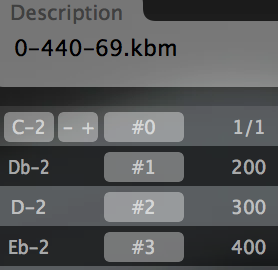It would be possible to make a full keyboard range SCL microtuning file that leaves most of the keyboard in 12 equal, then features a zone with non-12 intervals.
Facing such a task, I would be inclined to create the full range tuning in a spreadsheet using cents values, and just create the offsets needed in the unique zone(s) as a part of the whole tuning.
Knowing that 12 equal is 100 cents steps, create a SCL file that modifies the pitches you wish to offset in that region. MIDI Note 0, would be the 1/1 and have a value of 0 cents, then proceed to create the scale all the way through MIDI Note 127...
It might necessitate creating and using a special KBM file as well, where the 1/1 of the tuning would be mapped to MIDI Note 0, with what ever reference is needed, and I'm assuming standard concert 69.A @ 440 Hz for this.
As we know, usually, 12 equal will be this in cents:
0
100
200
300
400
500
600
700
800
900
1000
1100
1200
But as a framework for doing what you are suggesting, a full range mapping would look like this:
MIDI Cents
00 0
01 100
02 200
03 300
04 400
05 500
06 600
07 700
08 800
09 900
10 1000
11 1100
12 1200
13 1300
14 1400
15 1500
16 1600
17 1700
18 1800
19 1900
20 2000
21 2100
22 2200
23 2300
24 2400
25 2500
26 2600
27 2700
28 2800
29 2900
30 3000
31 3100
32 3200
33 3300
34 3400
35 3500
36 3600
37 3700
38 3800
39 3900
40 4000
41 4100
42 4200
43 4300
44 4400
45 4500
46 4600
47 4700
48 4800
49 4900
50 5000
51 5100
52 5200
53 5300
54 5400
55 5500
56 5600
57 5700
58 5800
59 5900
60 6000
61 6100
62 6200
63 6300
64 6400
65 6500
66 6600
67 6700
68 6800
69 6900
70 7000
71 7100
72 7200
73 7300
74 7400
75 7500
76 7600
77 7700
78 7800
79 7900
80 8000
81 8100
82 8200
83 8300
84 8400
85 8500
86 8600
87 8700
88 8800
89 8900
90 9000
91 9100
92 9200
93 9300
94 9400
95 9500
96 9600
97 9700
98 9800
99 9900
100 10000
101 10100
102 10200
103 10300
104 10400
105 10500
106 10600
107 10700
108 10800
109 10900
110 11000
111 11100
112 11200
113 11300
114 11400
115 11500
116 11600
117 11700
118 11800
119 11900
120 12000
121 12100
122 12200
123 12300
124 12400
125 12500
126 12600
127 12700
Should theoretically work in Pianoteq with an appropriate KBM file, such as something like this:
! 0-440-69.kbm
!
! Size of map:
0
! First MIDI note number to retune:
0
! Last MIDI note number to retune:
127
! Middle note where the first entry in the mapping is mapped to:
0
! Reference note for which frequency is given:
69
! Frequency to tune the above note to (floating point e.g. 440.0):
440.000000
! Scale degree to consider as formal octave:
0
! Mapping.
